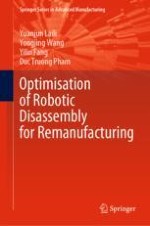This book illustrates the main characteristics, challenges and optimisation requirements of robotic disassembly. It provides a comprehensive insight on two crucial optimisation problems in the areas of robotic disassembly through a group of unified mathematical models. The online and offline optimisation of the operational sequence to dismantle a product, for example, is represented with a list of conflicting objectives and constraints. It allows the decision maker and the robots to match the situation automatically and efficiently.
To identify a generic solution under different circumstances, classical metaheuristics that can be used for the optimisation of robotic disassembly are introduced in detail. A flexible framework is then presented to implement existing metaheuristics for sequence planning and line balancing in the circumstance of robotic disassembly.
Optimisation of Robotic Disassembly for Remanufacturing provides practical case studies on typical product instances to help practitioners design efficient robotic disassembly with minimal manual operation, and offers comparisons of the state-of-the-art metaheuristics on solving the key optimisation problems. Therefore, it will be of interest to engineers, researchers, and postgraduate students in the area of remanufacturing.
